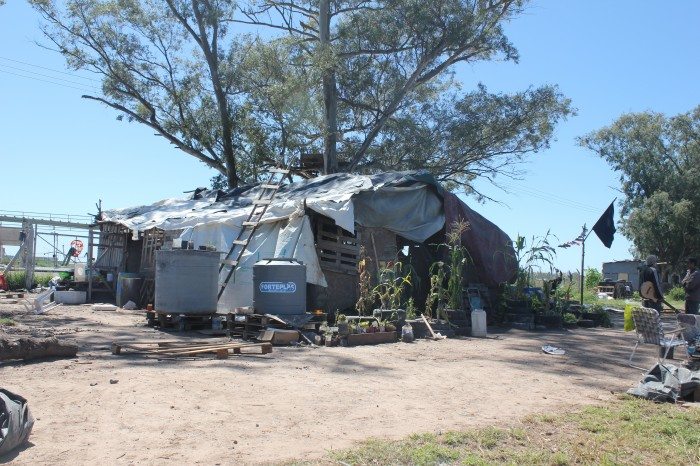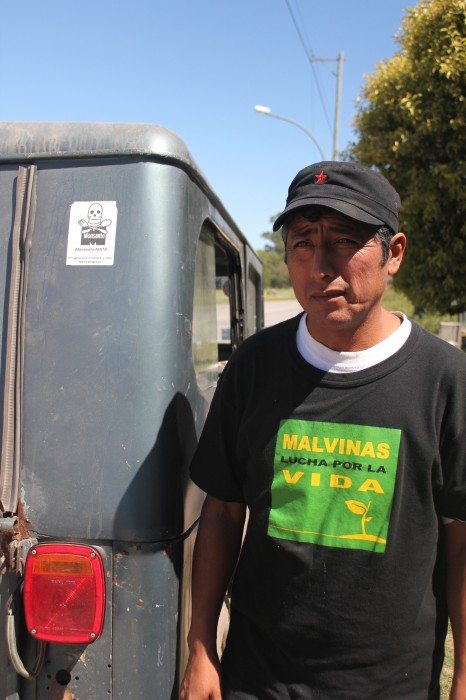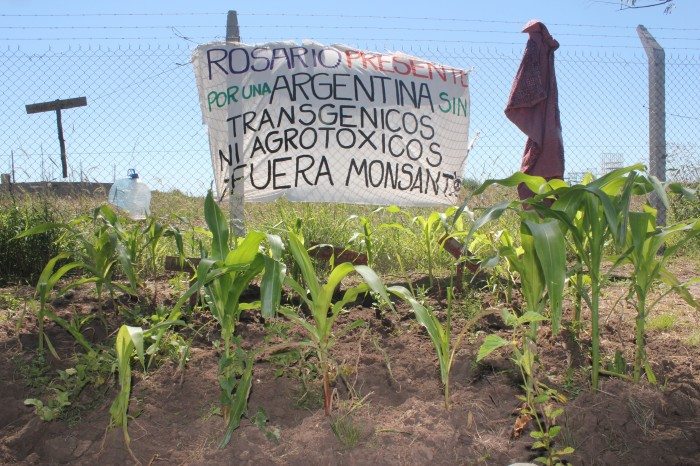MALVINAS ARGENTINAS, CÓRDOBA—For the first time in history, a campsite of neighbors in Argentina has stopped the construction of a multinational agriculture plant belonging to Monsanto.
For more than six months, residents of Malvinas Argentinas, a small town outside of Córdoba, Argentina, have been camping on the land occupied by Monsanto, a biotechnology multinational which creates anti-pest poisons for grain crops. Construction of the plant has been halted at 20% and the activist resistance continues after months of attacks, environmental studies and marches.
Last year, The Associated Press reported dozens of cases of food and water contamination in Argentina due to lack of protective gear for farm workers using anti-pest solutions and misuse of pesticide containers. Malvinas Argentinas Lucha Por La Vida (Fight for Life), the group that formed against the corporation as soon as Monsanto announced that it was going to begin construction, is defending itself against contamination.
Monsanto, whose world headquarters are St. Louis, Missouri, is the biggest producer of transgenic seeds in the world and usually appears in the list of “Top 10 Places to Work in Argentina.”
“We are very proud and happy to work here,” said Adrián Vilaplana, Corporate Affairs Manager at Monsanto and head of the project in Malvinas Argentinas. His first argument against the protestors was that they are not from Malvinas Argentinas.
Ironically, Malvinas Argentinas Lucha Por La Vida (MALPLV) made the same argument against Monsanto. “This is a national issue,” said Lucas Vaca, a member of the group. Eduardo Quispe, a member who has lived in the campsite for four months, said that the neighbors started to open their eyes to the issues presented by Monsanto’s construction plan.
Fight For Life
Two months after the protesters started camping out, Monsanto sent a letter to Sofía Gatica and Quispe, urging them to stop blocking construction. The letter said that if they continued to protest, they would be accused of crimes with punishments of up to three years in prison. Gatica is one of the founders of Madres de Itzaingó (a group formed 10 years ago to explore high cancer rates in the town of Ituzaingó).
“Monsanto, along with the government and UOCRA (construction worker union) have tried to kick us out with sticks, bullets and blows,” Gatica said. There have been 60 people injured in the conflicts, according to Gatica.
Monsanto argues that people are losing jobs because of the protests, but, according to a report by MALPLV, the majority of the workers contracted to work in the plant are not from Malvinas Argentinas.
“90% of the workers are from the outside,” Vaca said.
Vilaplana has invited Gatica to see Monsanto’s plant in Rojas, Buenos Aires Province, which is similar to the plant planned for Malvinas Argentinas. He also insists that the plant will not contaminate the town. “There is no chance of contamination,” he said. “I have personally invited Sofía Gatica to visit us with technicians and journalists, but she doesn’t want to come.”
MALPLV is worried about the toxic wind coming from the plant into the town. The construction site is to the east/northeast of the town, and the wind coming from this direction is very strong, according to a report by MALPLV.
“The cloud of toxic dust will fall on the town,” the report says. Located about one block from the construction site is an elementary school. The assembly members call it “one of the fumigated schools” because it is right next to a soy crop field.
So Much Soy
The amount of soy in Argentina has tripled since 1996, when the genetically modified Monsanto seed first arrived in Argentina. Because soy generated such a high profit, its usage grew exponentially. Today, the amount of soy grown in Argentina is five times the amount of corn. Argentina is now one of the top soy-producing countries in the world.
“Our current worry is the rate of crop rotation in the country. There is a lot of soy and few other crops,” Vilaplana said.
Ernesto Vázquez, a farmer from Córdoba, says that the overproduction of soy is a problem based on the market, not the law. “It’s advantageous for the farmer to plant soy because it isn’t consumed in the internal market, and it is taxed more than corn when it is exported,” he said.
But planting only soy without rotating in other crops has its price. “The problems with planting only one crop are serious, without a doubt. And we are very worried about that,” Vilaplana said. Problems that arise can include lack of nutrients in the soil, interruption of the natural soil recycling process and crops that are more susceptible to the spread of disease.
“This [the lack of rotation] was a decision made by the farmer himself, that unfortunately was not aware of the need to rotate at the time,” Vilaplana said. To combat this serious problem, the same company that brought GMO soy to Argentina over 20 years ago wants to have a 1 to 1 ratio between soy and corn. And to achieve this, Monsanto wants to construct the biggest corn plant in the world in a rural town with a population of 15,000: Malvinas Argentinas.
Contamination
Will the plant contaminate? Vilaplana compared Monsanto’s agrochemicals to Ford’s cars. The guilty party in a car accident is the person driving, and the guilty party in contamination is the farmer.
“Why are there cases of misuse? Because evidently there are people that do things well and people who don’t,” Vilaplana said.
However, the Associated Press documented several cases of contamination where toxic substances were used without scientific guidelines and with almost no state control. Not only did the report find workers using agrochemicals without necessary equipment, but it also found that the toxic substances were carried by the wind, contaminating schools, houses and water sources.
What does Monsanto do to prevent misuse? Vilaplana assures that the company communicates regularly with its clients to discuss the use of its products. He said that Monsanto has a close relationship with its farmers and that all products have labels about safety.
On the contrary, Vázquez said that only the largest producers have a direct relationship with the company. “Farmers have a relationship with Monsanto by way of their network of distributors that sell their products,” he explained.
Despite the evidence of misuse and contamination in rural towns, Vilaplana said that scientific evidence shows that there will be no contamination in Malvinas Argentinas. “We respond with scientific information,” he said. “Sofía Gatica is misinformed. We present technical information, they do not.”
MALPLV has technical information on its webpage about contamination, the Monsanto seed and what it means for Malvinas Argentinas. One of MALPV’s biggest concerns is the size of the multinational in comparison to the town.
“You can’t put a megacompany in a small town that doesn’t have healthcare infrastructure,” Vaca said. “They say that they will build a hospital but every contamination case is going to die here.”
Quispe is also worried about the lack of health care. “There is no follow-up,” he said. Cases of contamination are sent to the hospital in Córdoba and accounted for in the provincial statistics, therefore the rate of contamination in Malvinas Argentinas is lost in bureaucracy.
Future of Argentina Agriculture
To sway to people of Malvinas Argentinas, Monsanto has built two swimming pools and, according to the assembly, the company does big favors for people. “[Monsanto] manipulates and manages the people,” Vaca said. For Monsanto, losing this battle would mean much more than an economic loss. “What Monsanto has in Malvinas is chump change to them,” Vaca said. Monsanto can’t afford a loss because it would set a historical precedent.
On February 10, the Ministry of Environment did not authorize the environmental impact study that Monsanto submitted about the plant. The commission reported that the study did not meet the basic requirements of integrated waste management.
This was a big win for MALPLV.
What does Monsanto want for the future of the country? More agricultural biotechnology.
“There is no more land. There is more productivity, more technology. Producing more with less,” Vilaplana said.
What does Sofía Gatica want for the future of the country? A world without Monsanto.
“Monsanto, to me, is death,” she said.
***
Taylor Dolven is an “infinitely curious journalist” based in Argentina. You can follow her on Twitter @taydolven. She is part of a growing independent media movement in Argentina, miarevista.com.









The Gnostics derived their http://633cash.com/Games leading doctrines and ideas from Plato and Philo, the Zend-avesta, the Kabbalah, and the Sacred books of India and Egypt; and http://633cash.com/Pengaturan” thus introduced http://633cash.com/Daftar into the bosom of Christianity the cosmological and theosophical speculations, which had formed the larger portion of the ancient religions of the Orient, http://www.cintaberita.com joined to those of the Egyptian, Greek, http://633cash.com/Promo and Jewish doctrines, which the Neo-Platonists had equally adopted in the Occident..It is admitted that the cradle http://633cash.com/Deposit of http://633cash.com/Withdraw Gnosticism is probably to be looked for in Syria http://633cash.com/Berita and even in Palestine. Most of its expounders wrote in that corrupted form of the Greek used by the Hellenistic Jews…and there was a striking http://633cash.com/Girl analogy between their doctrines and those of the Judeo-Egyptian Philo of Alexandria; itself the seat of three schools, at once philosophic and religious, the http://633cash.com/LivescoreGreek, the Egyptian, and the Jewish. Pythagoras and Plato, the most mystical of the Grecian philosophers (the latter heir to the doctrines of the former), and who had travelled, the latter in Egypt, and the former in Phoenicia, India, and Persia, also taught the esoteric doctrine…The dominant doctrines of Plutonism were found in Gnosticism